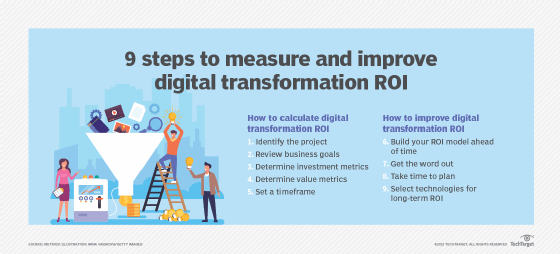9 tips to measure and improve digital transformation ROI
Amid a rapidly changing business landscape and competing priorities, a compelling ROI is all the more critical to justify and secure funding for digital transformation projects.
Digital transformation initiatives in most companies have accelerated and taken on greater urgency to manage increasingly distributed cloud environments, detect heightened security risks, accommodate the new reality of hybrid and remote workforces, improve customer experiences and gain a competitive edge. Projects range from using chatbot technologies that engage customers on the channel of their choice to automating workflows and manufacturing operations to incorporating generative AI and large language models into business decision-making.
As digital transformation projects increase in scope, demonstrating a compelling ROI is vital for digital transformation teams to earn support and funding for additional digital initiatives. Yet many companies continue to overlook ways to measure digital transformation ROI and improve it over time.
Digital transformation is defined as the innovative application of a new or existing technology that improves or creates a process, product or experience and ultimately drives business value. Digital transformation goals typically address revenue increase, cost savings, customer experience improvement and employee productivity gain. Ultimately, for-profit companies want to raise profits, while not-for-profit organizations want to run more efficiently.
Most digital transformation initiatives are focused on improving the customer experience, according to Metrigy's research. In 2023, 82.7% of companies have completed, are in the process of completing or planning a CX transformation project, up from only 53% in 2022. The goal is to use technologies such as AI, analytics and self-service to improve customer interactions, delivering an ROI that can be measured in several ways.
This article is part of
What is digital transformation? Everything you need to know
Measurement techniques can include formulas like the cost-benefit ratio as in the equation ROI = (benefits - costs) / costs or more advanced methods such as net present value, internal rate of return or payback period. Whatever the choice, calculating and improving digital transformation ROI requires several steps.

How do you calculate digital transformation ROI?
The tendency of some business leaders is to insist a digital transformation project be up and running ASAP, pointing to competitors who have a digital transformation roadmap in place. But transformative projects such as improving customer service or increasing efficiency with new technology require careful planning. It's imperative to slow down and think methodically about the project and calculate a realistic ROI. The following tips are best illustrated using an example in the healthcare field as a model.
1. Identify the project
Address a business problem or opportunity. Think about how existing or new technologies could be used to better adapt your digital business model to market conditions. For the healthcare model, let's imagine that a four-physician medical clinic identifies an opportunity to start a telehealth line of business to serve patients who are unable to get to the clinic and can be served remotely.
2. Review business goals
Decide what business goals the project should address. Will it increase revenue, decrease costs, improve customer ratings or boost employee productivity? In the healthcare example, the goal might be to increase the number of patients seen per hour, thus increasing revenue. Adding telehealth services also might improve patient satisfaction ratings, resulting in more referrals to grow the practice.
3. Determine investment metrics
The investment figures typically should be detailed and may include technologies and services like network infrastructure, applications, monitoring tools and security, project staffing, direct sales, customer service, advertising and digital marketing, user awareness and adoption, and consultants. For the medical clinic project, let's calculate that the initial infrastructure and associated marketing to start a telehealth service costs $320,000 and the ongoing costs to support the system are $65,000.
4. Determine value metrics
Identify the metrics needed to show the return on the budgeted digital investment. For the medical clinic project, the before-and-ongoing metrics needed to measure the success or failure of the identified business goals include the number of physicians, number of patients seen per day, average revenue per patient, patient satisfaction score and referrals per patient.
5. Set a timeframe
The average time period to complete a transformation project is six months. But stakeholders funding these projects rarely have the patience to wait that long for results. When calculating metrics, start by noting the current baseline figures so there's a basis for comparison once the project is completed. Assuming the medical clinic project, including marketing and training, takes six months to complete, the following approach will yield ROI:
- Run the math. The baseline shows that each of the four physicians normally sees 20 patients per day, with an average per-patient revenue of $350. Annual revenue is $7.28 million. With telehealth, they can see 2.5 patients per hour, with an average revenue per patient of $200. The total annual revenue will be $8.32 million, a 14% increase of $1.04 million per year.
- Calculate the ROI. The project's first year costs are $320,000, but revenue calculations are only based on six months because of the time it took to set up the systems for the telehealth model. So, the ROI is $200,000, meaning the investment costs are not yet recouped. By the second year, however, the ROI will be the full revenue minus costs, or $975,000.
- Determine additional digital transformation business benefits. Some benefits may be hard to quantify initially and require new tools to track progress, so the business model must factor in "what if" scenarios. If the medical clinic, for example, knows that it receives an average of 0.3 referrals from each patient, it can track whether that referral figure increases with the new telehealth service and, more specifically, if those referrals were the result of a patient using the service. In that case, the project owner can add the additional revenue from the referred patients to the equation, documenting even more success.
How can you improve digital transformation ROI?
Numerous other factors go into an ROI, such as depreciation, net present value and additional ancillary costs that emerge in designated years. The key is to measure baseline figures, track costs and the scheduled time frame to complete the project, and document long-term success. It's important to look for ways to improve with each new digital transformation initiative, so that business outcomes are more convincing to support the next project. The following tips can improve ROI on your digital transformation projects.
6. Build the ROI model ahead of time
Use estimated figures to ensure all the pertinent metrics are tracked. If you don't gather all the necessary figures early, it'll be too late by the end of the project.
7. Get the word out
One of the biggest reasons transformation projects -- along with the anticipated ROI -- don't come to fruition is employees or customers don't know there's a new technology or process that can produce benefits. Culture plays a critical role in the success or failure of digital transformation projects. When more people are affected by the transformation initiative, ROI is usually bigger.
8. Take time to plan
IT or business leaders are often in such a rush to get a project off the ground, they don't take the time to gather business unit requirements or estimate the time it takes to test applications or train people. This approach is a recipe for digital transformation failures. When time and cost estimates exceed expectations, the transformation already carries a dark cloud before the first ROI figure is reported. By planning properly and setting realistic expectations, the project will run more smoothly.
9. Evaluate technologies carefully
ROI is significantly affected by the technologies selected and implemented. Don't just select the cheapest technology to improve ROI. You may find value in spending more on an application that's easier to manage. The upfront cost will be greater, but the operational costs will be lower, and that will increase ROI over time.







